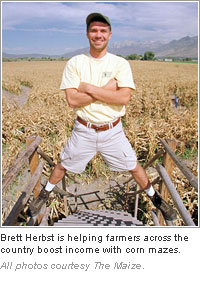提到美國(guó)的農(nóng)業(yè)你首先會(huì)想到的會(huì)是什么呢?是發(fā)達(dá)的機(jī)械化?是一望無(wú)際的原野還是什么其他的呢?無(wú)可置疑的,與中國(guó)農(nóng)業(yè)相比,美國(guó)的農(nóng)業(yè)技術(shù)非常的現(xiàn)代化,但在本文中,我們?yōu)槟榻B的并非是路人皆知的現(xiàn)代化機(jī)器,而是一種新的農(nóng)業(yè)旅游經(jīng)濟(jì)——谷物迷宮,它不僅增加了農(nóng)民的收入,更增添了一道美麗的經(jīng)濟(jì)風(fēng)景線。
An Amazing Moneymaker
For city dwellers(城市居住者) and suburbanites(住市郊的人), the month of October may just seem like a 30-day prelude (前序)to the spookiest(幽靈般的) night of the year. Far removed from "the land," it's easy to forget that October is also harvest time, when the rewards of the growing season are finally reaped. That also makes it the perfect time of year for cornfield mazes(谷物迷宮).

According to the USDA(美國(guó)農(nóng)業(yè)部), between 1974 and 2002, the number of corporate-owned farms(企業(yè)擁有農(nóng)田) in the U.S. increased by more than 36 percent, and between 2005 and 2006, we lost 8,900 farms. Family farms, as most folks know, need all the help they can get--and ag-tourism (農(nóng)業(yè)旅游)like corn mazes is one way family farmers are increasing profits.
One man in particular has pushed the corn maze craze to the next level in the U.S. Brett Herbst started his own corn maze in American Fork, Utah(猶他州的亞美尼加弗), in 1996, after reading about a similar enterprise in Pennsylvania. A recent agribusiness graduate (農(nóng)業(yè)綜合企業(yè)畢業(yè)生)of Brigham Young University(楊白翰大學(xué)), he rented land and got to work. Herbst then helped his sister and a friend create mazes the next year. After the second year, the media began reporting on the mazes.
"So many people heard about [the corn mazes] from all different parts of the country. That's when people started calling us, and saying, 'Hey, we want to do something like this. What would it cost?' And we're going, 'Huh, we could probably charge money for this,'" recalls Herbst, who then started The Maize, a company with three full-time employees and many seasonal workers (季節(jié)性員工)that helps more than 190 farms create mazes each year in the U.S., Canada and Europe.
Designs are only limited to the farmers' imaginations: Past maze themes include Napoleon Dynamite(拿破侖), Gerald Ford (福特)and John Wayne(約翰韋恩). Herbst, who still rents land to run his own maze in Lehi(利希,地名), Utah, but owns a farm in Springville, Utah, even won the Guinness World Record for the world's largest corn maze in 1999 with a cosmic, space-inspired design.
Though most corn mazes are open to visitors only during October, Herbst starts helping his clients design the mazes in February. Some folks cut their own mazes, which begins when the corn is low in June, while others pay The Maize to do it. Herbst also offers marketing support, including a page on his website, though his clients arrange for their own aerial photographs (飛機(jī)上拍攝的照片)of the mazes. In the late autumn and early winter, Herbst takes care of his financial tasks and finishes up his own farming work. Then it starts all over again.
Out on the Farm(農(nóng)場(chǎng)之外)
Laurie and Ken Graff are using The Maize's services on their family farm and ranch (農(nóng)場(chǎng)和牧場(chǎng))in Hondo, Texas(得克薩斯本州), for the seventh year--though they do things a little differently. "Our maze is grown out of hay grazer(干草), the stuff hay bales are made out of. Corn doesn't grow well in late July when our maze is planted, due to excessive heat and bug problems(持續(xù)的高溫和蟲(chóng)害問(wèn)題)," explains Laurie, whose 900-acre farm and ranch have been in Ken's family since the 1850s. They've had more than 110,000 visitors to their maze, not including their current season.
Laurie says they first decided to create the maze to diversify(多樣化) and generate more income. Herbst explains that's often the case. With multinational companies(跨國(guó)公司) taking over the agriculture business, it can be very difficult to compete. "The family farm has 20 acres or 100 acres. How do you compete with this corporate farm that's got 50,000 acres and is bringing stuff in from Mexico or Australia," asks Herbst, who has helped create more than 1,200 mazes since 1996. "Ag-tourism(農(nóng)業(yè)旅游) and corn mazes are an avenue to drive people directly to your farm and get that income directly from the consumer."
Extending the Experience(擴(kuò)張經(jīng)驗(yàn))
Indeed, it's the value-added experience(增值的旅游經(jīng)歷) that brings visitors to farms. Most corn maze operators offer other activities, like hay rides(坐草車), bounce houses(充氣家具), farming demonstrations(農(nóng)場(chǎng)解說(shuō)), apple picking(采摘蘋(píng)果), pumpkin patches(收獲南瓜), mini mazes(小迷宮) or petting zoos(愛(ài)畜動(dòng)物園). "Successful mazes often are part of a larger ag-tourism business," says Dan Looker, business editor for Successful Farming magazine(《成功農(nóng)場(chǎng)》), who adds that some farmers also have opened bed and breakfasts or started companies allowing customers to be a farmer for a day.
"They aren't farming in the traditional sense," Looker says. "In fact, a maze is an entirely new business with a whole new set of planning requirements--crowd control(人群控制), parking(停車), increased insurance liability(增加保險(xiǎn)責(zé)任), additional hired help(額外的臨時(shí)幫工) and the need to provide complementary services like food, refreshments, souvenirs, which also increase revenue."
In Temecula, California(加利福尼亞的蒂梅丘拉), a growing area outside of Los Angeles, the Big Horse Feed and Corona Ranch and Land Company(公司名) offers different activities each weekend at its corn maze like "Old Fashioned Farm Days(傳統(tǒng)農(nóng)場(chǎng))," which features demonstrations of blacksmithing(手工鍛造), wool spinning (羊毛紡紗)and sheep shearing(剪羊毛).
"It's family entertainment. Everybody can enjoy it from 4 to 80," says Rose Corona, who runs the family ranch and business with her brother Steve. They donate all the profits from the maze to organizations like the YMCA(基督教青年) and the Marine Corps(海軍陸戰(zhàn)隊(duì)). "It's not anything fancy, but I think a lot of people think it's amazing because they never get a chance to go on a farm."











